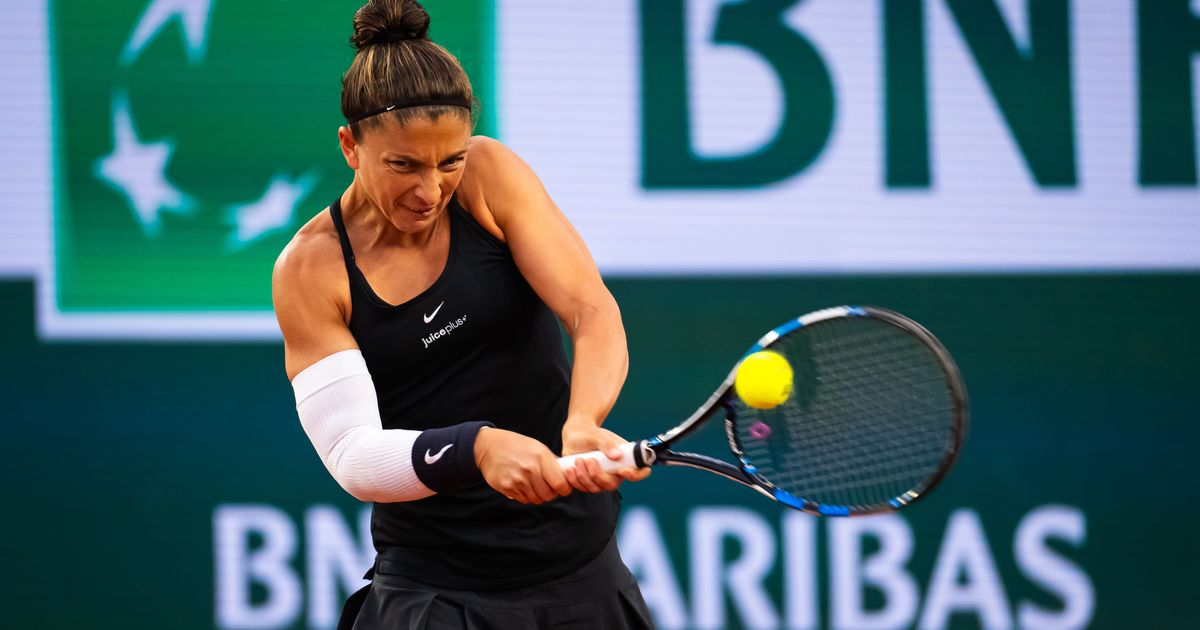
PARIS — Her results coming into qualifying at Roland Garros weren’t terrific, so Yuliia Starodubtseva didn’t have great expectations.
And yet Friday, after she won her third match in four days, she was into the main draw of a Grand Slam for only the second time.
“The feeling itself is incredible,” the 24-year-old from Ukraine told WTAtennis.com. “I’m just super, super, super happy with that performance last three matches.”
Yes, she used the word “super” three times. Small wonder, for her 6-3, 6-2 win over Marina Stakusic may have been career-altering. Starodubtseva had just secured 73,000 Euros in winnings — roughly one-third of her career prize money.
NBC analyst Mary Carillo, on hand for these proceedings, has one word for the qualifying process: fraught.
“Lives,” she said, “change in an instant.”
Starodubtseva nodded her head vigorously.
“It does, it does,” she said, laughing at the absurdity. “It feels like you’re entering a new style of life, to be honest. Because you’re in last 128 in the world right now. You’re in the tournament, playing in the same draw with the best players.”
Numbers game
It’s the tournament within the tournament, the unseen undercard.
While World No.1 Iga Swiatek dropped in on the draw ceremony or was hitting balls with actress Courteney Cox, the players ranked outside the Top 100 were scuffling through five days of qualifying, mostly on the outside courts at Roland Garros.
Casual tennis fans may not know their names, but these players are well within the top one percent of the world’s top one percent. On Friday, when Coco Gauff was chatting live on the “Today Show,” Olga Danilovic was out on Court 12, trying to reach her fifth major main draw in four years.
“I don’t know if people realize it, but these are great players,” Danilovic said after defeating Astra Sharma 7-6(2), 7-5 in the third round of qualifying. “There’s not one easy match that you play. It’s so tough. You want to play main draw, you want to play as much as you can. But sometimes it’s just that pressure of knowing you have to beat so many great players to come to the main draw.”
Just like that main draw, the qualifying tournament begins with a 128-player grid, which, after three highly competitive rounds, gets reduced to 16, plus lucky losers. The play is spirited and, at 10 Euros for admission, child-friendly and one of the best entertainment values in sport. Roland Garros set a Week 1 record of more than 75,000 spectators.
The intrigue began on Sunday when the No.212-ranked Emma Raducanu, the 2021 US Open champion, withdrew. When the April 29 cutoff for Roland Garros arrived, Sara Errani was ranked No.100 — and missed the main draw by one spot. That made the 37-year-old Italian the top seed in qualifying. Julia Riera, 21, of Argentina was the No.2 seed and Hungary’s Anna Bondar, 26, was No.3.
Nine wild cards, all of them French players, were sifted into the draw; two of them made the second round but none survived to play the third.
The stakes, in terms of money and rankings points, couldn’t be much higher for these players. The payoff for merely playing a first-round match was 20,000 Euros, while advancing to the second and third rounds was worth 28,000 and 41,000, respectively.
On the line in a third-round qualifying match was an additional €32,000 for advancing. That adds up to €73,000 if you qualify, more than many people make in a single year and a significant amount for these players trying to survive on the tour. It’s estimated that professionals need to be ranked somewhere between 80 and 100 to create a positive cash flow for the year; it’s expensive traveling the world and that doesn’t include paying a coach or trainer.
There were also ranking points in play (10 for appearing in the first round), with the possibility of 70 for a win. It doesn’t sound like much, but those 70 points can be enough to lift a player ranked outside No.100 into the low 90s — enough to secure a major main draw without having to qualify.
The qualifying procedure is the same for each of the four Grand Slams
- The top ranked 100 or so players when the pre-tournament deadline arrives several weeks earlier are guaranteed a spot in the main draw.
- The next 100 or so are eligible for the qualifying draw. Just as in the main draw, wild cards and lucky losers (following withdrawals) fill out the field to 128.
- Players must win three qualifying matches to advance to the main draw.
Thus, when a big point arrives in qualifying, players say it’s difficult not to think about the repercussions.
“One million percent,” said Hailey Baptiste, an engaging 21-year-old American who came in as the No.6 seed. “It happened a couple of weeks ago when I was in Rome. I had match points in my first qualifying match. If I won that match, I think I would have been in main draw at Wimbledon.”
Instead, she lost to Jaqueline Cristian in three sets.
“Definitely, I was thinking about that,” Baptiste said. “It was tough, and now I’m playing [Wimbledon] qualifying. It’s always going to be in the back of your head, whether it’s points, money, whatever the case.
“You just have to focus on yourself in the moment and not let those things be at the center of your brain. It’s almost impossible but you have to overpower those thoughts and think of something else.”
Surviving a whirlwind
Baptiste got to the third round but lost to No.25 seed Tamara Zidansek 7-5, 1-6, 6-3. Zidansek, a 26-year-old from Slovenia recovering from bacterial pneumonia, is one of only two qualifiers to have won a WTA Tour-level title, three years ago in Lausanne.
The other? It was Errani, a nine-time singles champion, a former World No.5 and winner of more than $14 million in prize money. Consider the chaotic past week of her life:
Last Sunday, she was playing the doubles final in Rome with Jasmine Paolini. Stadio Centrale was jam-packed and lusty and loud in their support for the Italian pair. In the end, they defeated Gauff and Erin Routliffe 10-8 in a third-set super tiebreaker.
Two days later, after jumping on a plane that evening and practicing for one hour on Monday, she was out on Court Suzanne Lenglen, playing the first round of qualifying against Ann Li. Quite a swing of events for the 2012 Roland Garros finalist (she lost to Maria Sharapova) and a semifinalist the next year.
With her high-pitched trademark grunts and wearing a bulky wrap on her right elbow, Errani threw up an array of loopy forehands and artful slices. She was serving at 5-3 in the opening set, tied at deuce, when she suddenly stopped playing. There was no call, but Errani thought Li’s shot was out. After the chair umpire confirmed her suspicion, Errani — who would have faced a critical break point — took the set and, ultimately, the match 6-3, 6-4.
Notable qualifiers
- Moyuka Uchijima, a 22-year-old from Japan who has won 25 of 26 matches, mostly on the ITF circuit. In the third round, she beat Raluka Serban, who was aiming to become the first Cypriot woman ever in a Slam main draw.
- Irene Burillo Escorihuela was ranked No.235 at the qualifying cutoff and was listed as 10thalternate. The 26-year-old Spaniard and four others ranked below her actually got in.
- Zeynep Sonmez became the first woman from Turkey in a Grand Slam main singles draw since 2017 and only the third ever.
- Julia Avdeeva, 21, hit 74 aces in five matches to win an ITF tournament earlier this year.
- Lucija Ciric Bagaric, at 20 the youngest qualifier, had career winnings of $69,030 — and surpassed that in one week.
On Friday, Errani won her third qualifying match on Lenglen in four days.
“Tired, very tired,” she told WTAtennis.com. “I love it, but it’s also my job. I think many people have to go to work when they are tired, so I’m lucky it’s something that I love to do.
“But I’m very happy because this is why you do it. Tennis, it gives me a lot. Some good emotions, so I think I play for that.”
Heading into 2024, Errani thought this might be her last year. Now that she’ll go directly into Wimbledon’s main singles draw, she’s not so sure.
“We will see of course,” Errani said. “If I finish the year in maybe Top 100 and I’m still feeling good physically, why not to continue? When I don’t want to do it anymore, I will stop.”
Errani, by far the oldest of the qualifiers (eight years senior to Brazil’s Laura Pigossi who is the next) is also the most heavily decorated of this year’s 19 qualifiers. That includes lucky losers Jana Fett, Panna Udvardy and Dalma Galfi, who got into the main draw when Jessica Pegula, Taylor Townsend and Jodie Burrage withdrew. There’s a reason they call them lucky. At Grand Slams, the names of the six highest-ranked players who lost in the third round are thrown into a hat — and are randomly drawn to fill the available spots.
In the end, 13 of the 19 qualifiers were seeded. The average age was 24.6 years, and the average ranking was No.134.
The most favorable matchup? Qualifiers Irene Burillo Escorihuela and Moyuka Uchijima play each other. One will advance to likely play No.2 Aryna Sabalenka.
A life-changing event
After winning the first set of her third-round match, Starodubtseva tried to quiet her racing brain by reading from her notebook during the changeover. She reminded herself to keep her feet moving and reviewed tactical strategy. Still, those thoughts of glory, points and money seeped in.
“Of course they did,” she said after the breakthrough victory. “I will invest my winnings in my tennis, unfortunately. I started playing professionally a little over a year ago after college [Old Dominion University]. I do financial all myself.”
Though none of these qualifiers, based on their ranking, are expected to win, history says that some of them likely will. They’re tired after three matches, yes, but also in a groove, already accustomed to Roland Garros’s quirky conditions.
Whatever happens, the quality of Starodubtseva’s tennis life will improve dramatically.
“It means I’ll travel more with my coach,” she said. “It means I’ll take care of my body more. Get a trainer, or maybe my own physio. I still think I need to pass a couple of rounds for a physio.”
And she laughed.
“It will take away a lot of pressure financially,” she said. “Just not having money in your mind helps you play better, for sure. You have a safety net where you can relax a little bit and take care of everything else.”
Source: https://www.wtatennis.com/news/4027889/qualifying-at-roland-garros-the-grueling-journey-that-can-change-careers


